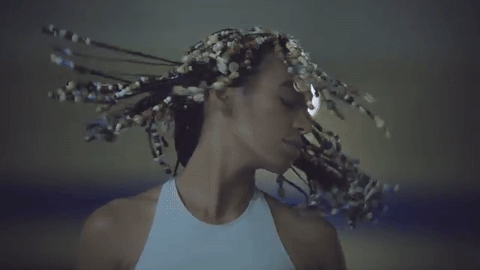The Audacity of Solange in 'Don't Touch My Hair'
If the hairstyles are the paint in Solange's "Don't Touch My Hair," then the Black bodies are surely the canvas.
Me and my Black hair and Black music go way back.
Back to those days spent in a jam-packed braiding shop, focusing on the homemade West African music videos ahead to distract me from my tender headed woes. Back to those days spent waiting for my $20 wash, roller-set and wrap at the Haitian hair salon; where I felt womanly getting my newly-relaxed hair primped to a soundtrack of kompa tunes, Creole chatter and angry blowdryers.
Back to that time studying abroad in South Africa, when I stood before my bathroom mirror, having finally convinced myself to forgo transitioning from my chemically straightened hair to my natural hair texture. With a fistful of hair in one hand, a pair of all-purpose scissors in the other and India Arie's “I Am Not My Hair" on full blast, I started down a new path of self-exploration with about an inch of soft, wooly coils covering my head.
A few months later, much to my delight, Solange also made the decision to chop it all off. I remember surfing the internet in my dorm room and stumbling across the news and accompanying photograph. There she was in a sun dress, shades and a low haircut sporting her natural hair. This was a big deal, people.
Let me give you some context: The year was 2009. I was no longer in South Africa, where Black women with cropped natural hair abound, but instead in my final year at Amherst College, a predominantly white liberal arts college in a predominantly white town. My self-confidence ebbed and flowed between “Yas" to “WTFDIDYOUDO?!" and today's empowering natural hair blogs and vlogs were scant, Afrobella aside.
It was also a year after Solange debuted her psychedelic, post-neo soul, #carefreeblackgirl-before-it-became-a-thing album Sol-Angel and the Hadley St. Dreams. So, yes, Solange's pioneering decision to sport an unconventional hairstyle historically reserved for Black men and run the risk of public ridicule was a big deal to me and many other Black women, young and old.
So, it came as no surprise to longtime fans that the same sparkle of self-determination Solange shared with the world seven years ago had matured into her latest album A Seat At the Table, a dazzling beam of self-love, Black pride and kujichagulia.
And seeing as how this is a thought piece on Black hair and Black music and the personal experiences that tie them together, let's focus on “Don't Touch My Hair."
Nestled among multi-textured layers of lush, thought-provoking tracks, DTMH is one of the more lyrically abstract numbers on the album. As abstract as the complex paintings of Black abstractionists Romare Bearden, Shinique Smith, and Alma Thomas.
In fact, I'd argue that DTMH, along with A Seat At the Table as a whole, serves as a plot of freshly tilled fertile ground gifted to each listener, an opportunity to plant, grow and harvest one's own thoughts on the album's subject matter—which range from clear cut talks on Black artists knowing their self-worth to ambiguous reflections on airborne cranes and unrelenting metal clouds.
Given the simultaneously pointed (Don't touch Solange's hair. Period.), yet abstract nature of DTMH, the track's transition to visual is a smooth and continuous one, with no apparent gaps between the two mediums.
Solange and her co-director and husband Alan Ferguson paint the music video with broad pastel shots: small braids adorned to the roots, retro fingerwaves, voluminous waves and intricate threaded updos reminiscent of Nigerian photographer J.D. Okhai Ojeikere's “Hairstyles."
And if the hairstyles are the paint, then the Black bodies are surely the canvas, live works of art and vehicles of an unapologetic perspective from a person confident enough to leave it open to interpretation.
And, with Solange, that's what it really circles back to, from the big chop to A Seat At the Table. She has the audacity to cut off all her hair and wear it proudly beside her superstar sister on the red carpet. She has the audacity to create an inclusive album made explicitly for Black people in an exclusive predominantly white industry.
An audacity of self-love, self-confidence and self-determination that persists in spite of perpetual attempts at snuffing it out.
#BlackGirlMagic in all its glory. We got so much ya'll.
Patrice Peck lives at the intersection of culture, technology, new media and #blackgirlmagic. When she's not putting an end to #blacksalonproblems with her beauty services startup CRÈME, she's pondering her next hairstyle and exploring New York City.
Follow her on Instagram at @speakpatrice.
- In Photos: Solange's Groundbreaking Guggenheim Concert ... ›
- Solange Declares 'I Am a Proud Black Feminist' In Bust Magazine ... ›
- Solange's New Album Is a Portal Into the Spaces That Define Us ... ›
- Watch Solange (and Sampha) Slay on SNL With 'Cranes in the Sky ... ›
- Solange and Miguel Are Headed to South Africa for This Year's ... ›
- Angelica Nwandu Is Launching 3 New Original Series on The Shade Room - Okayplayer ›
